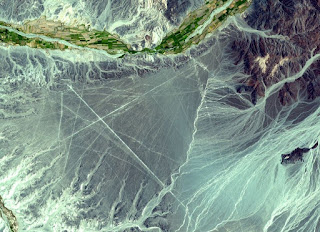The Nazca culture flourished beside the dry southeast coast of Peru close to the Rio Grande de Nazca in the Ica Valley:
 |
| Map of Nazca Line Area |
The Nazca produced an array beautiful crafts and technologies such as ceramics, textiles, and geoglyphs, the latter most commonly known as the Nazca Lines. Early Nazca society was made up of local chieftains with its regional power center in Cahuachi.
| Cahauchi |
Cahuachi overlooked some of the Nazca Lines like the ones below:
This nearby ray center could have been a landing site for the Ancient Astronauts adjacent to Cahuachi, where it would have been easy for them to meet with the Nazca. Cahuachi contains over 40 mounds topped with adobe structures. A pyramid is at the center of a huge architectural complex covering o.6 miles . The permanent population was small and was probably the site where their biggest religious ceremonies took place.
 |
| Ray Center Near Cahauchi |
 |
| Cahauchi Adobe Pyramid |
Cahuachi became a pilgrimage center and grew greatly in population when major ceremonial-religious events took place. These events probably invoked the Nazca Lines and the Great Sand Dune of Nazca. Support for the pilgrimage theory comes from archeological evidence at Cahuachi and from the Nazca Lines which shows such creatures as the orca and monkeys. It is thought that Cahuachi was the capitol of the Nazca State, and if not that then the closest thing to one. Cahuachi lies in the lower portion of the Nazca Valley and was initially occupied during the late Paracas Period. It is entirely unique of all the Nazca sites. Excavations at Cahuachi have given archeologists insight into the Nazca culture. The remains that are found are large amounts of polychrome pottery, there is evidence of maize, squash, beans, peanuts, as well as some fish, plain and fancy textiles, trace amounts of gold in their beads and an array of ritual paraphernalia.
 |
| Nazca Polychrome Ceramic Orca |
Much of Nazca art depicts powerful nature gods, such as the killer whale and the spotted cat, and serpentine creatures, which was the most prevalent of worshipped figures. Similar to the Moche culture, the shamans apparently used hallucinogenic drugs taken from the San Pedro Cactus to induce visions, which is depicted on their pottery and textiles.
The Nazca were head-hunters. There is a debate over the purpose of trophy heads which continues to this day. Whether they were trophies of war or objects of ritual. Trophy heads all had one common modification - a hole in the forehead through which a rope could be affixed permanently so that the head could be displayed or carried. The Nazca believed that the spirit was located in the head.
 |
| A Nazca Trophy Head |
The Nazca, like all Pre-Columbian societies in South America, including the Inca, had no writing system so they did not write in the alphabetic sense, this is one of the reasons that makes it so hard to study them. In the case where a culture has no writing system and no method of written communication, the method of sending a message had to be through their artwork, on their ceramics, on their architectural structures-and the Nazca Lines. Here cognitive archeology focuses on the way ancient societies thought and the symbolic structures that are perceived in past material culture. The way that these abstract ideas are manifested through the remains that these people left behind, can be investigated and debated often by drawing inferences from such fields as semiotics (the study of the sign processes-signs and symbols), psychology and wider sciences (such as engineering and mathematics). Thus the iconography or symbols painted on their ceramics served as a means of communication-motifs came in two major categories-sacred and profane, and since there is no one left alive who is a direct descendant of this culture- to pass on these traditions -we must rely on the evidence the Nazca left behind.
 |
| Small Nazca Village |
The village’s name is Pueblo Veiejo it is located about 2 miles south of Cahauchi. The Nazca Lines are located a little over 31 miles east of the Pacific coast.






















